Management Accounting Report: Cost Analysis for Jeffrey and Sons
VerifiedAdded on 2020/01/15
|25
|7192
|76
Report
AI Summary
This report provides a comprehensive analysis of management accounting principles applied to a case study involving Jeffrey and Sons, a company manufacturing branded products. The report begins with an introduction to management accounting and its significance in cost control and decision-making. Task 1 delves into cost classification, job costing, and absorption costing techniques, including detailed calculations of unit costs and total job costs for specific jobs. Task 2 focuses on preparing and analyzing cost reports, including variance analysis and performance indicators to identify areas for improvement. Task 3 explores the budgeting process, examining different budgeting methods and the preparation of various budget types, including a cash budget. Finally, Task 4 involves the calculation of variances, the preparation of a reconciliation operating statement, and providing findings to management based on identified responsibility centers. The report concludes with a summary of key findings and recommendations.
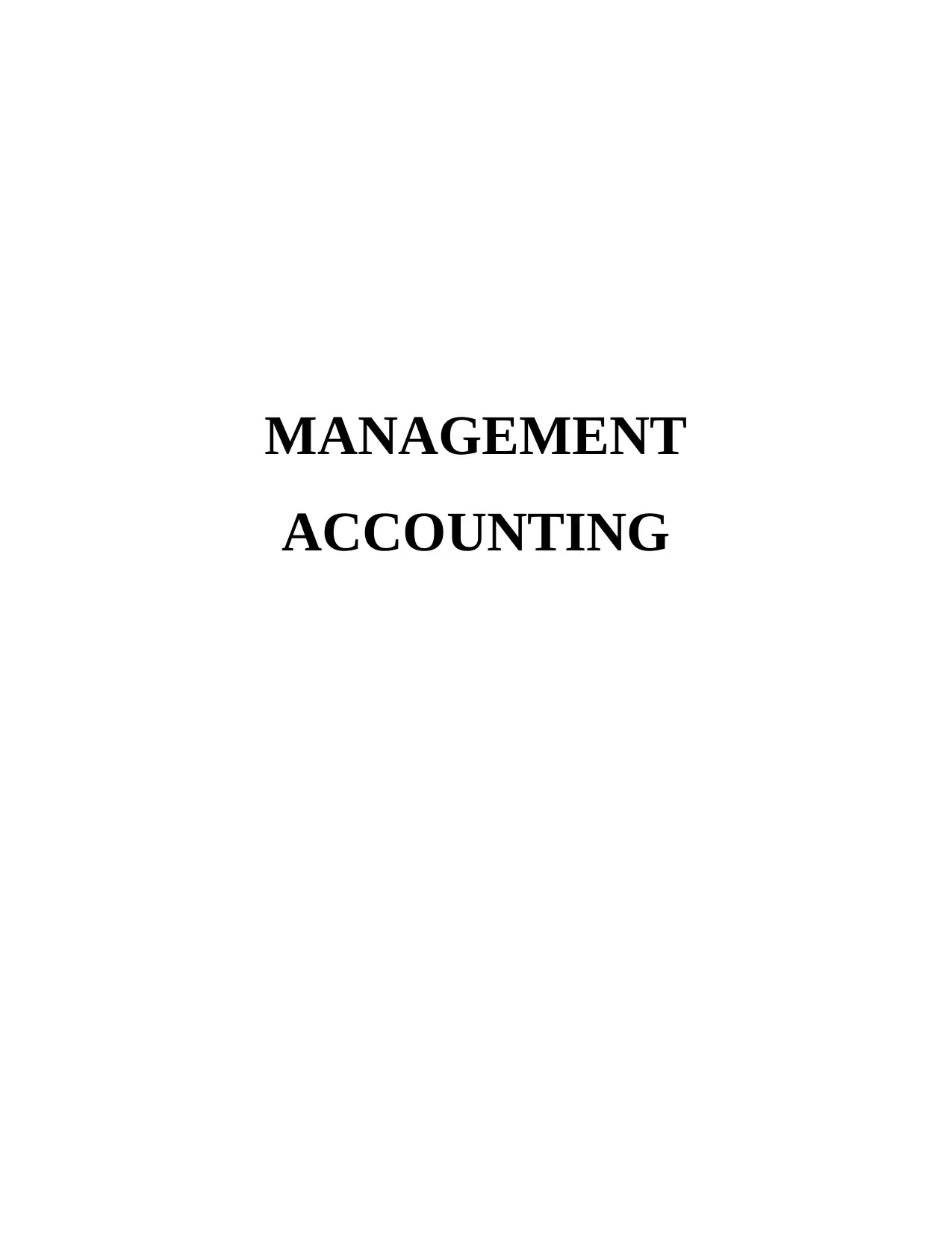
MANAGEMENT
ACCOUNTING
ACCOUNTING
Paraphrase This Document
Need a fresh take? Get an instant paraphrase of this document with our AI Paraphraser
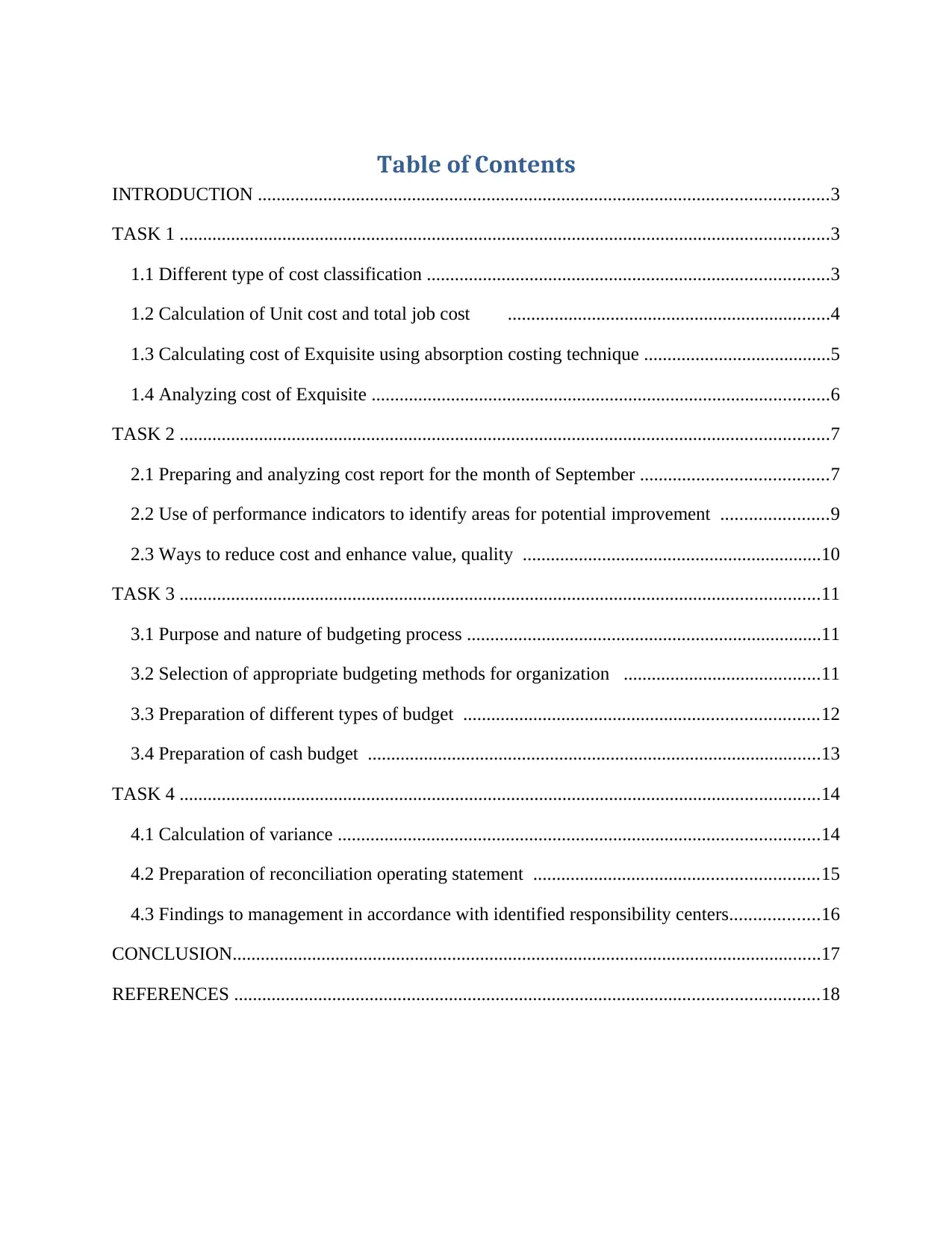
Table of Contents
INTRODUCTION ..........................................................................................................................3
TASK 1 ...........................................................................................................................................3
1.1 Different type of cost classification ......................................................................................3
1.2 Calculation of Unit cost and total job cost .....................................................................4
1.3 Calculating cost of Exquisite using absorption costing technique ........................................5
1.4 Analyzing cost of Exquisite ..................................................................................................6
TASK 2 ...........................................................................................................................................7
2.1 Preparing and analyzing cost report for the month of September ........................................7
2.2 Use of performance indicators to identify areas for potential improvement .......................9
2.3 Ways to reduce cost and enhance value, quality ................................................................10
TASK 3 .........................................................................................................................................11
3.1 Purpose and nature of budgeting process ............................................................................11
3.2 Selection of appropriate budgeting methods for organization ..........................................11
3.3 Preparation of different types of budget ............................................................................12
3.4 Preparation of cash budget .................................................................................................13
TASK 4 .........................................................................................................................................14
4.1 Calculation of variance .......................................................................................................14
4.2 Preparation of reconciliation operating statement .............................................................15
4.3 Findings to management in accordance with identified responsibility centers...................16
CONCLUSION..............................................................................................................................17
REFERENCES .............................................................................................................................18
INTRODUCTION ..........................................................................................................................3
TASK 1 ...........................................................................................................................................3
1.1 Different type of cost classification ......................................................................................3
1.2 Calculation of Unit cost and total job cost .....................................................................4
1.3 Calculating cost of Exquisite using absorption costing technique ........................................5
1.4 Analyzing cost of Exquisite ..................................................................................................6
TASK 2 ...........................................................................................................................................7
2.1 Preparing and analyzing cost report for the month of September ........................................7
2.2 Use of performance indicators to identify areas for potential improvement .......................9
2.3 Ways to reduce cost and enhance value, quality ................................................................10
TASK 3 .........................................................................................................................................11
3.1 Purpose and nature of budgeting process ............................................................................11
3.2 Selection of appropriate budgeting methods for organization ..........................................11
3.3 Preparation of different types of budget ............................................................................12
3.4 Preparation of cash budget .................................................................................................13
TASK 4 .........................................................................................................................................14
4.1 Calculation of variance .......................................................................................................14
4.2 Preparation of reconciliation operating statement .............................................................15
4.3 Findings to management in accordance with identified responsibility centers...................16
CONCLUSION..............................................................................................................................17
REFERENCES .............................................................................................................................18
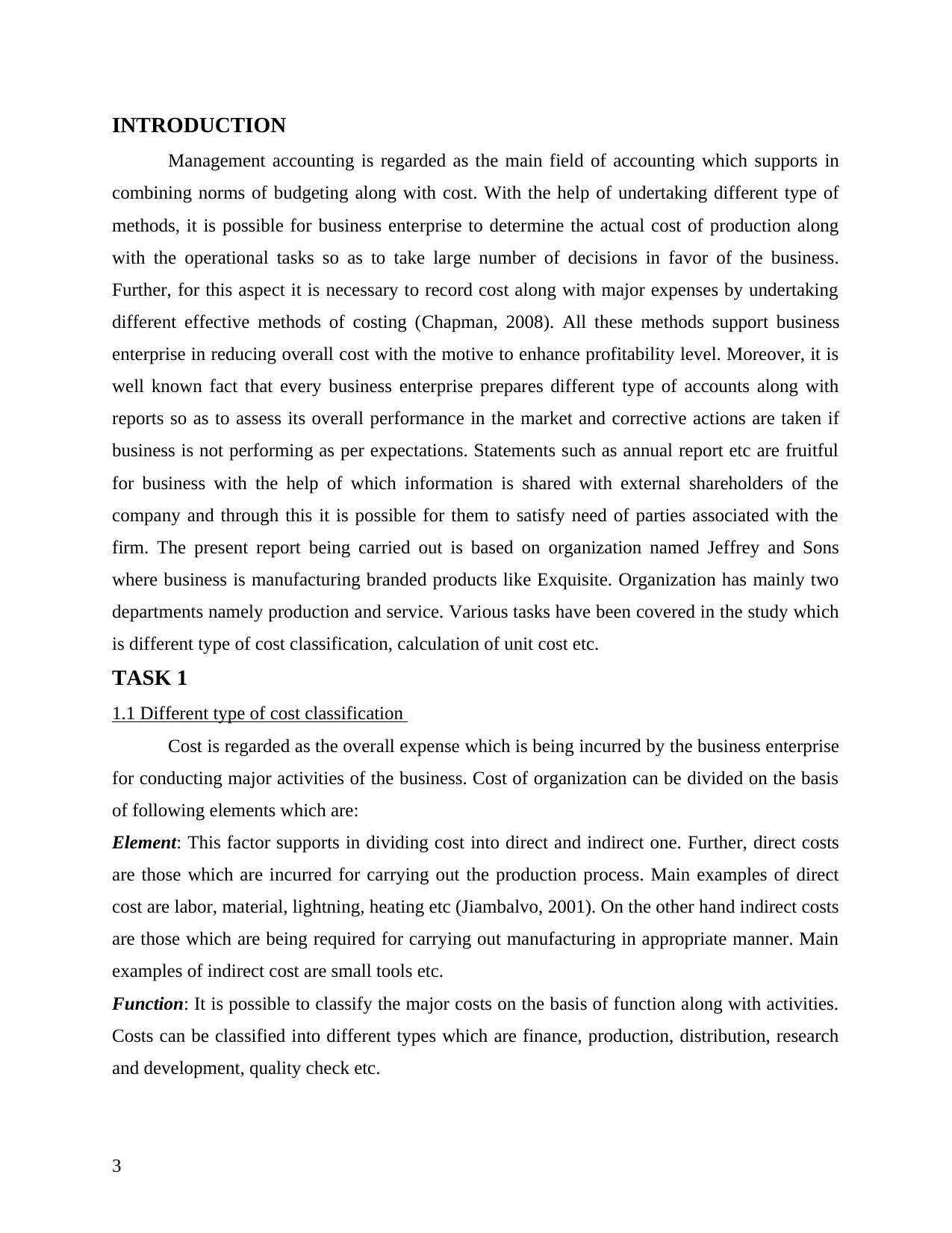
INTRODUCTION
Management accounting is regarded as the main field of accounting which supports in
combining norms of budgeting along with cost. With the help of undertaking different type of
methods, it is possible for business enterprise to determine the actual cost of production along
with the operational tasks so as to take large number of decisions in favor of the business.
Further, for this aspect it is necessary to record cost along with major expenses by undertaking
different effective methods of costing (Chapman, 2008). All these methods support business
enterprise in reducing overall cost with the motive to enhance profitability level. Moreover, it is
well known fact that every business enterprise prepares different type of accounts along with
reports so as to assess its overall performance in the market and corrective actions are taken if
business is not performing as per expectations. Statements such as annual report etc are fruitful
for business with the help of which information is shared with external shareholders of the
company and through this it is possible for them to satisfy need of parties associated with the
firm. The present report being carried out is based on organization named Jeffrey and Sons
where business is manufacturing branded products like Exquisite. Organization has mainly two
departments namely production and service. Various tasks have been covered in the study which
is different type of cost classification, calculation of unit cost etc.
TASK 1
1.1 Different type of cost classification
Cost is regarded as the overall expense which is being incurred by the business enterprise
for conducting major activities of the business. Cost of organization can be divided on the basis
of following elements which are:
Element: This factor supports in dividing cost into direct and indirect one. Further, direct costs
are those which are incurred for carrying out the production process. Main examples of direct
cost are labor, material, lightning, heating etc (Jiambalvo, 2001). On the other hand indirect costs
are those which are being required for carrying out manufacturing in appropriate manner. Main
examples of indirect cost are small tools etc.
Function: It is possible to classify the major costs on the basis of function along with activities.
Costs can be classified into different types which are finance, production, distribution, research
and development, quality check etc.
3
Management accounting is regarded as the main field of accounting which supports in
combining norms of budgeting along with cost. With the help of undertaking different type of
methods, it is possible for business enterprise to determine the actual cost of production along
with the operational tasks so as to take large number of decisions in favor of the business.
Further, for this aspect it is necessary to record cost along with major expenses by undertaking
different effective methods of costing (Chapman, 2008). All these methods support business
enterprise in reducing overall cost with the motive to enhance profitability level. Moreover, it is
well known fact that every business enterprise prepares different type of accounts along with
reports so as to assess its overall performance in the market and corrective actions are taken if
business is not performing as per expectations. Statements such as annual report etc are fruitful
for business with the help of which information is shared with external shareholders of the
company and through this it is possible for them to satisfy need of parties associated with the
firm. The present report being carried out is based on organization named Jeffrey and Sons
where business is manufacturing branded products like Exquisite. Organization has mainly two
departments namely production and service. Various tasks have been covered in the study which
is different type of cost classification, calculation of unit cost etc.
TASK 1
1.1 Different type of cost classification
Cost is regarded as the overall expense which is being incurred by the business enterprise
for conducting major activities of the business. Cost of organization can be divided on the basis
of following elements which are:
Element: This factor supports in dividing cost into direct and indirect one. Further, direct costs
are those which are incurred for carrying out the production process. Main examples of direct
cost are labor, material, lightning, heating etc (Jiambalvo, 2001). On the other hand indirect costs
are those which are being required for carrying out manufacturing in appropriate manner. Main
examples of indirect cost are small tools etc.
Function: It is possible to classify the major costs on the basis of function along with activities.
Costs can be classified into different types which are finance, production, distribution, research
and development, quality check etc.
3
⊘ This is a preview!⊘
Do you want full access?
Subscribe today to unlock all pages.

Trusted by 1+ million students worldwide
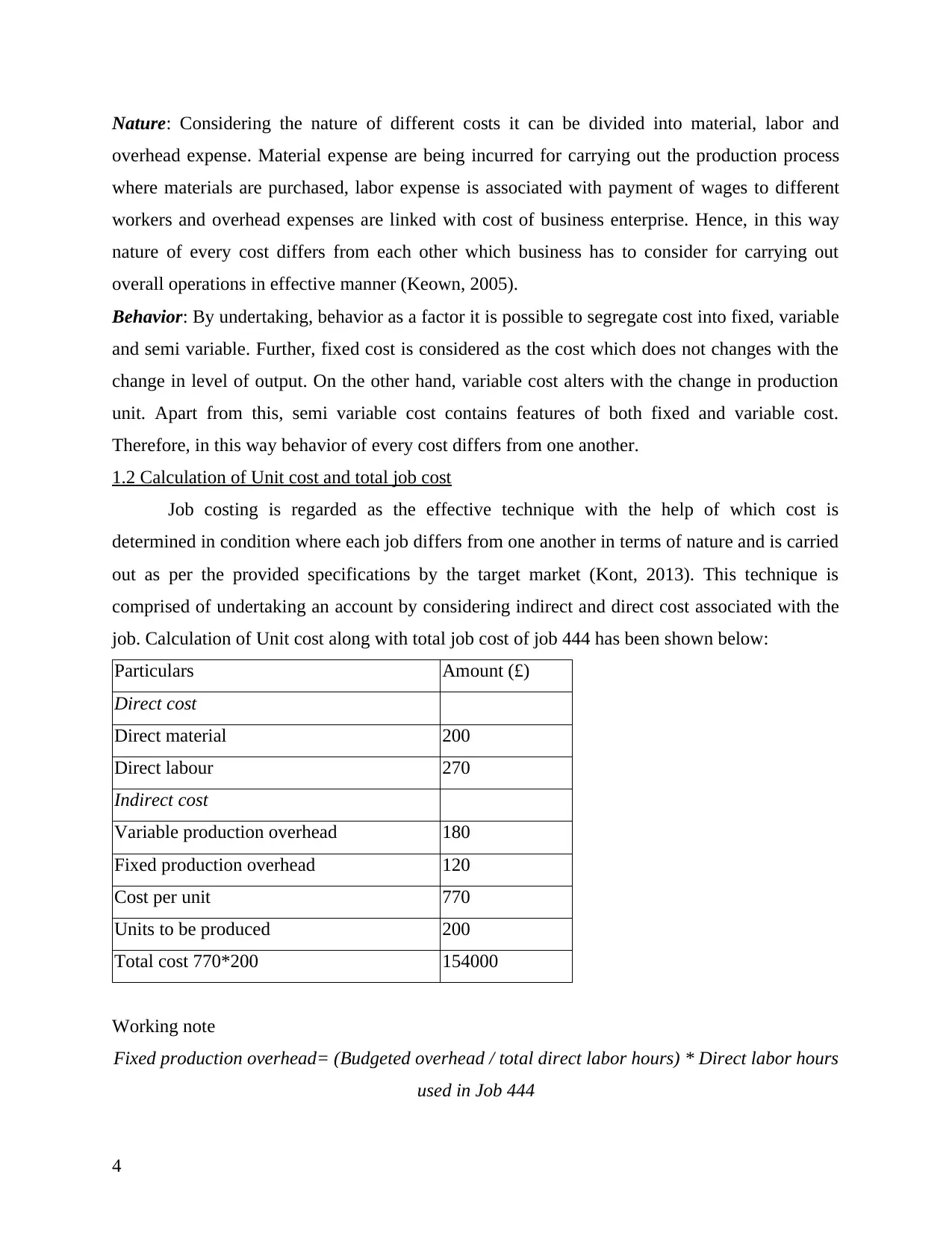
Nature: Considering the nature of different costs it can be divided into material, labor and
overhead expense. Material expense are being incurred for carrying out the production process
where materials are purchased, labor expense is associated with payment of wages to different
workers and overhead expenses are linked with cost of business enterprise. Hence, in this way
nature of every cost differs from each other which business has to consider for carrying out
overall operations in effective manner (Keown, 2005).
Behavior: By undertaking, behavior as a factor it is possible to segregate cost into fixed, variable
and semi variable. Further, fixed cost is considered as the cost which does not changes with the
change in level of output. On the other hand, variable cost alters with the change in production
unit. Apart from this, semi variable cost contains features of both fixed and variable cost.
Therefore, in this way behavior of every cost differs from one another.
1.2 Calculation of Unit cost and total job cost
Job costing is regarded as the effective technique with the help of which cost is
determined in condition where each job differs from one another in terms of nature and is carried
out as per the provided specifications by the target market (Kont, 2013). This technique is
comprised of undertaking an account by considering indirect and direct cost associated with the
job. Calculation of Unit cost along with total job cost of job 444 has been shown below:
Particulars Amount (£)
Direct cost
Direct material 200
Direct labour 270
Indirect cost
Variable production overhead 180
Fixed production overhead 120
Cost per unit 770
Units to be produced 200
Total cost 770*200 154000
Working note
Fixed production overhead= (Budgeted overhead / total direct labor hours) * Direct labor hours
used in Job 444
4
overhead expense. Material expense are being incurred for carrying out the production process
where materials are purchased, labor expense is associated with payment of wages to different
workers and overhead expenses are linked with cost of business enterprise. Hence, in this way
nature of every cost differs from each other which business has to consider for carrying out
overall operations in effective manner (Keown, 2005).
Behavior: By undertaking, behavior as a factor it is possible to segregate cost into fixed, variable
and semi variable. Further, fixed cost is considered as the cost which does not changes with the
change in level of output. On the other hand, variable cost alters with the change in production
unit. Apart from this, semi variable cost contains features of both fixed and variable cost.
Therefore, in this way behavior of every cost differs from one another.
1.2 Calculation of Unit cost and total job cost
Job costing is regarded as the effective technique with the help of which cost is
determined in condition where each job differs from one another in terms of nature and is carried
out as per the provided specifications by the target market (Kont, 2013). This technique is
comprised of undertaking an account by considering indirect and direct cost associated with the
job. Calculation of Unit cost along with total job cost of job 444 has been shown below:
Particulars Amount (£)
Direct cost
Direct material 200
Direct labour 270
Indirect cost
Variable production overhead 180
Fixed production overhead 120
Cost per unit 770
Units to be produced 200
Total cost 770*200 154000
Working note
Fixed production overhead= (Budgeted overhead / total direct labor hours) * Direct labor hours
used in Job 444
4
Paraphrase This Document
Need a fresh take? Get an instant paraphrase of this document with our AI Paraphraser
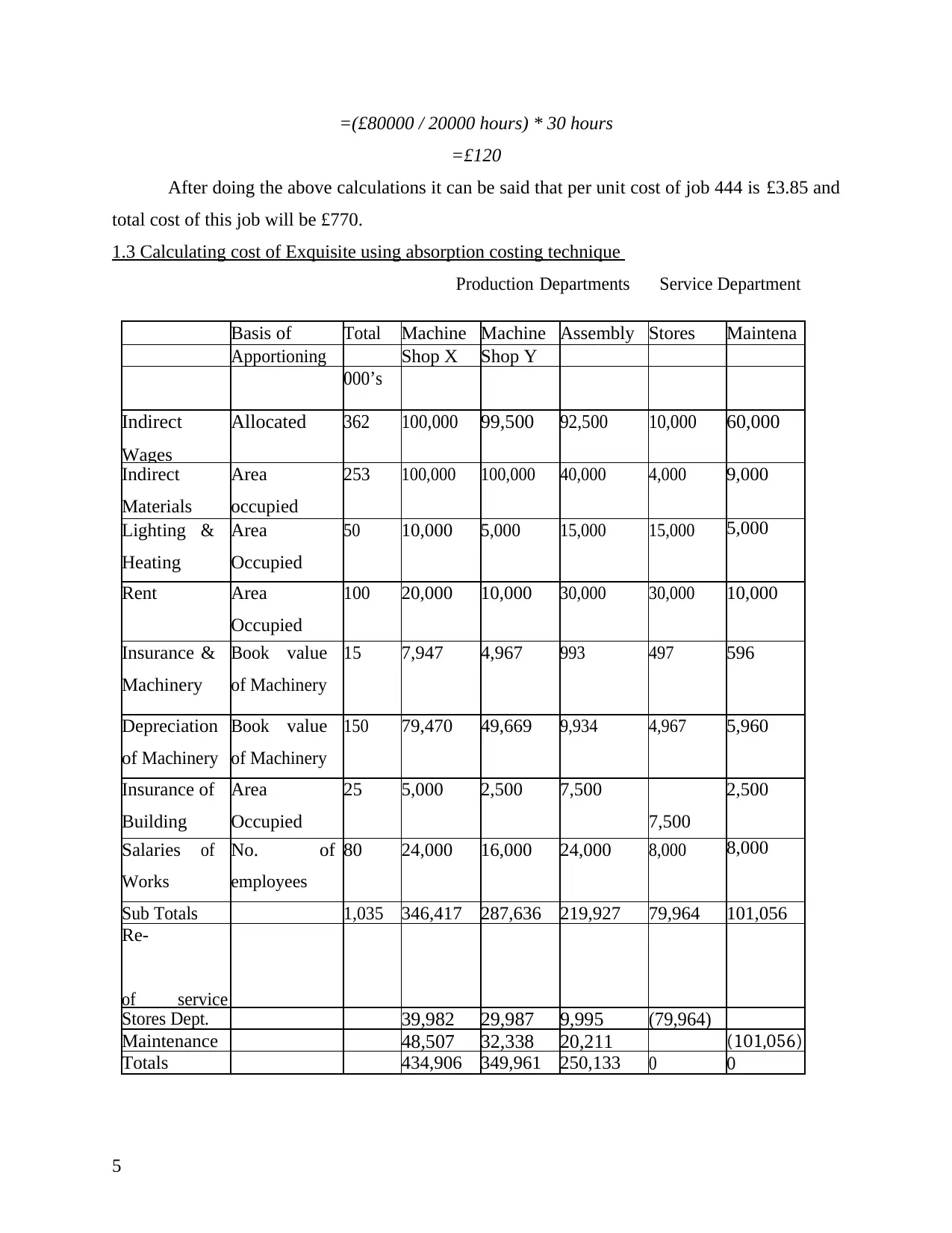
=(£80000 / 20000 hours) * 30 hours
=£120
After doing the above calculations it can be said that per unit cost of job 444 is £3.85 and
total cost of this job will be £770.
1.3 Calculating cost of Exquisite using absorption costing technique
Production Departments Service Department
Basis of Total Machine Machine Assembly Stores Maintena
nceApportioning Shop X Shop Y
000’s
Indirect
Wages
Allocated 362 100,000 99,500 92,500 10,000 60,000
Indirect
Materials
Area
occupied
253 100,000 100,000 40,000 4,000 9,000
Lighting
Heating
& Area
Occupied
50 10,000 5,000 15,000 15,000 5,000
Rent Area
Occupied
100 20,000 10,000 30,000 30,000 10,000
Insurance &
Machinery
Book value
of Machinery
15 7,947 4,967 993 497 596
Depreciation
of Machinery
Book value
of Machinery
150 79,470 49,669 9,934 4,967 5,960
Insurance of
Building
Area
Occupied
25 5,000 2,500 7,500
7,500
2,500
Salaries
Works
of No.
employees
of 80 24,000 16,000 24,000 8,000 8,000
Sub Totals 1,035 346,417 287,636 219,927 79,964 101,056
Re-
of service
Stores Dept. 39,982 29,987 9,995 (79,964)
Maintenance 48,507 32,338 20,211 (101,056)
Totals 434,906 349,961 250,133 0 0
5
=£120
After doing the above calculations it can be said that per unit cost of job 444 is £3.85 and
total cost of this job will be £770.
1.3 Calculating cost of Exquisite using absorption costing technique
Production Departments Service Department
Basis of Total Machine Machine Assembly Stores Maintena
nceApportioning Shop X Shop Y
000’s
Indirect
Wages
Allocated 362 100,000 99,500 92,500 10,000 60,000
Indirect
Materials
Area
occupied
253 100,000 100,000 40,000 4,000 9,000
Lighting
Heating
& Area
Occupied
50 10,000 5,000 15,000 15,000 5,000
Rent Area
Occupied
100 20,000 10,000 30,000 30,000 10,000
Insurance &
Machinery
Book value
of Machinery
15 7,947 4,967 993 497 596
Depreciation
of Machinery
Book value
of Machinery
150 79,470 49,669 9,934 4,967 5,960
Insurance of
Building
Area
Occupied
25 5,000 2,500 7,500
7,500
2,500
Salaries
Works
of No.
employees
of 80 24,000 16,000 24,000 8,000 8,000
Sub Totals 1,035 346,417 287,636 219,927 79,964 101,056
Re-
of service
Stores Dept. 39,982 29,987 9,995 (79,964)
Maintenance 48,507 32,338 20,211 (101,056)
Totals 434,906 349,961 250,133 0 0
5
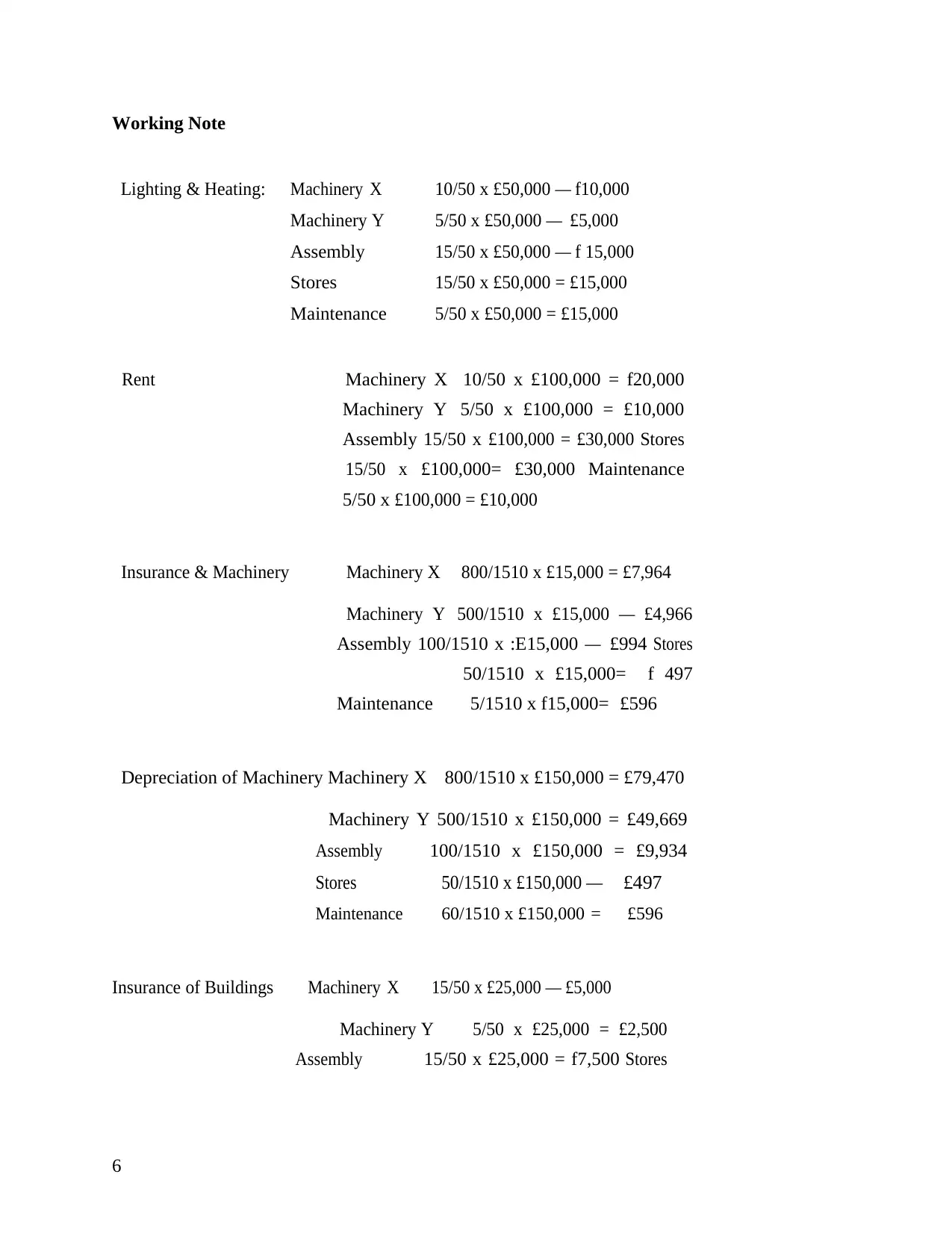
Working Note
Lighting & Heating: Machinery X 10/50 x £50,000 — f10,000
Machinery Y 5/50 x £50,000 — £5,000
Assembly 15/50 x £50,000 — f 15,000
Stores 15/50 x £50,000 = £15,000
Maintenance 5/50 x £50,000 = £15,000
Rent Machinery X 10/50 x £100,000 = f20,000
Machinery Y 5/50 x £100,000 = £10,000
Assembly 15/50 x £100,000 = £30,000 Stores
15/50 x £100,000= £30,000 Maintenance
5/50 x £100,000 = £10,000
Insurance & Machinery Machinery X 800/1510 x £15,000 = £7,964
Machinery Y 500/1510 x £15,000 — £4,966
Assembly 100/1510 x :E15,000 — £994 Stores
50/1510 x £15,000= f 497
Maintenance 5/1510 x f15,000= £596
Depreciation of Machinery Machinery X 800/1510 x £150,000 = £79,470
Machinery Y 500/1510 x £150,000 = £49,669
Assembly 100/1510 x £150,000 = £9,934
Stores 50/1510 x £150,000 — £497
Maintenance 60/1510 x £150,000 = £596
Insurance of Buildings Machinery X 15/50 x £25,000 — £5,000
Machinery Y 5/50 x £25,000 = £2,500
Assembly 15/50 x £25,000 = f7,500 Stores
6
Lighting & Heating: Machinery X 10/50 x £50,000 — f10,000
Machinery Y 5/50 x £50,000 — £5,000
Assembly 15/50 x £50,000 — f 15,000
Stores 15/50 x £50,000 = £15,000
Maintenance 5/50 x £50,000 = £15,000
Rent Machinery X 10/50 x £100,000 = f20,000
Machinery Y 5/50 x £100,000 = £10,000
Assembly 15/50 x £100,000 = £30,000 Stores
15/50 x £100,000= £30,000 Maintenance
5/50 x £100,000 = £10,000
Insurance & Machinery Machinery X 800/1510 x £15,000 = £7,964
Machinery Y 500/1510 x £15,000 — £4,966
Assembly 100/1510 x :E15,000 — £994 Stores
50/1510 x £15,000= f 497
Maintenance 5/1510 x f15,000= £596
Depreciation of Machinery Machinery X 800/1510 x £150,000 = £79,470
Machinery Y 500/1510 x £150,000 = £49,669
Assembly 100/1510 x £150,000 = £9,934
Stores 50/1510 x £150,000 — £497
Maintenance 60/1510 x £150,000 = £596
Insurance of Buildings Machinery X 15/50 x £25,000 — £5,000
Machinery Y 5/50 x £25,000 = £2,500
Assembly 15/50 x £25,000 = f7,500 Stores
6
⊘ This is a preview!⊘
Do you want full access?
Subscribe today to unlock all pages.

Trusted by 1+ million students worldwide
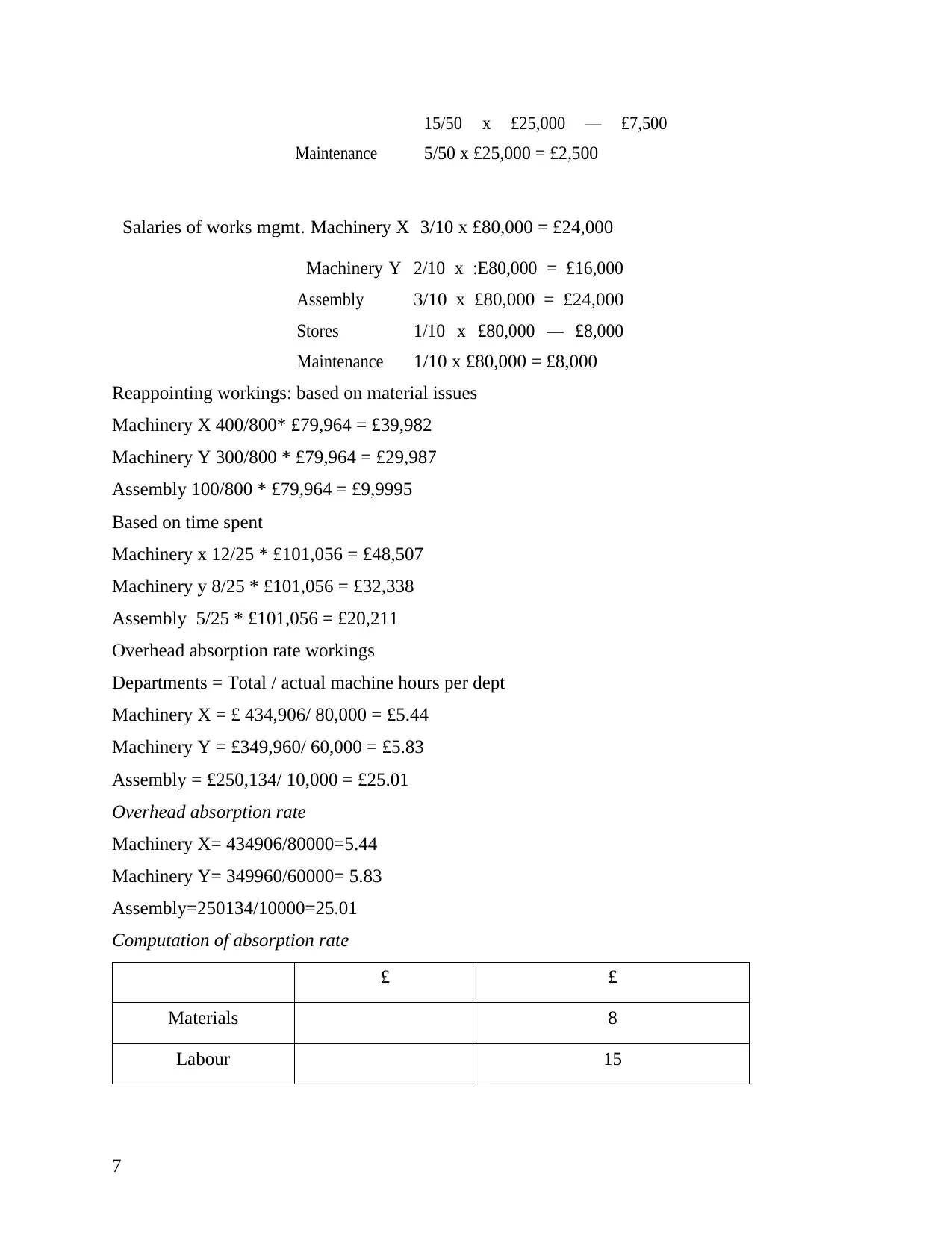
15/50 x £25,000 — £7,500
Maintenance 5/50 x £25,000 = £2,500
Salaries of works mgmt. Machinery X 3/10 x £80,000 = £24,000
Machinery Y 2/10 x :E80,000 = £16,000
Assembly 3/10 x £80,000 = £24,000
Stores 1/10 x £80,000 — £8,000
Maintenance 1/10 x £80,000 = £8,000
Reappointing workings: based on material issues
Machinery X 400/800* £79,964 = £39,982
Machinery Y 300/800 * £79,964 = £29,987
Assembly 100/800 * £79,964 = £9,9995
Based on time spent
Machinery x 12/25 * £101,056 = £48,507
Machinery y 8/25 * £101,056 = £32,338
Assembly 5/25 * £101,056 = £20,211
Overhead absorption rate workings
Departments = Total / actual machine hours per dept
Machinery X = £ 434,906/ 80,000 = £5.44
Machinery Y = £349,960/ 60,000 = £5.83
Assembly = £250,134/ 10,000 = £25.01
Overhead absorption rate
Machinery X= 434906/80000=5.44
Machinery Y= 349960/60000= 5.83
Assembly=250134/10000=25.01
Computation of absorption rate
£ £
Materials 8
Labour 15
7
Maintenance 5/50 x £25,000 = £2,500
Salaries of works mgmt. Machinery X 3/10 x £80,000 = £24,000
Machinery Y 2/10 x :E80,000 = £16,000
Assembly 3/10 x £80,000 = £24,000
Stores 1/10 x £80,000 — £8,000
Maintenance 1/10 x £80,000 = £8,000
Reappointing workings: based on material issues
Machinery X 400/800* £79,964 = £39,982
Machinery Y 300/800 * £79,964 = £29,987
Assembly 100/800 * £79,964 = £9,9995
Based on time spent
Machinery x 12/25 * £101,056 = £48,507
Machinery y 8/25 * £101,056 = £32,338
Assembly 5/25 * £101,056 = £20,211
Overhead absorption rate workings
Departments = Total / actual machine hours per dept
Machinery X = £ 434,906/ 80,000 = £5.44
Machinery Y = £349,960/ 60,000 = £5.83
Assembly = £250,134/ 10,000 = £25.01
Overhead absorption rate
Machinery X= 434906/80000=5.44
Machinery Y= 349960/60000= 5.83
Assembly=250134/10000=25.01
Computation of absorption rate
£ £
Materials 8
Labour 15
7
Paraphrase This Document
Need a fresh take? Get an instant paraphrase of this document with our AI Paraphraser
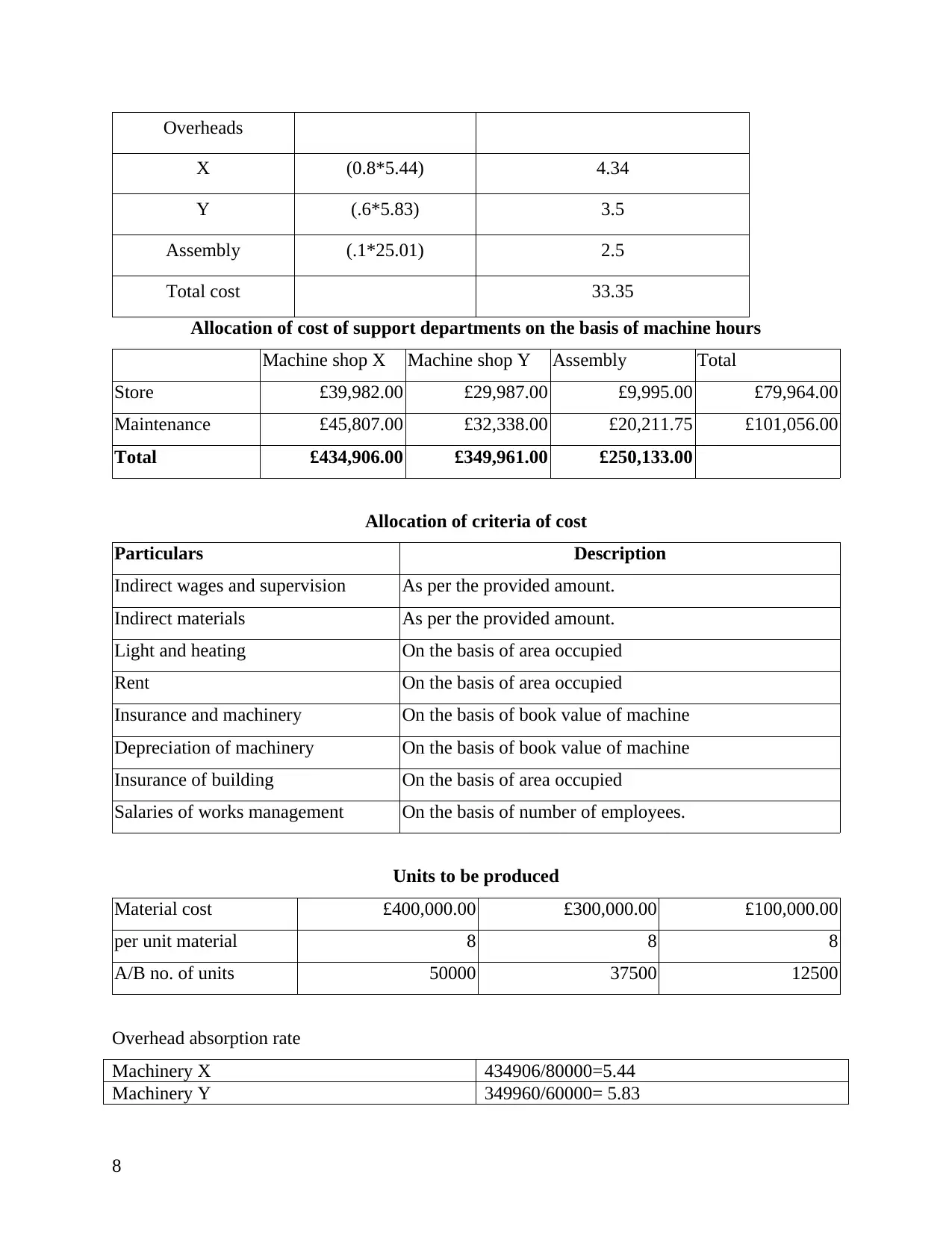
Overheads
X (0.8*5.44) 4.34
Y (.6*5.83) 3.5
Assembly (.1*25.01) 2.5
Total cost 33.35
Allocation of cost of support departments on the basis of machine hours
Machine shop X Machine shop Y Assembly Total
Store £39,982.00 £29,987.00 £9,995.00 £79,964.00
Maintenance £45,807.00 £32,338.00 £20,211.75 £101,056.00
Total £434,906.00 £349,961.00 £250,133.00
Allocation of criteria of cost
Particulars Description
Indirect wages and supervision As per the provided amount.
Indirect materials As per the provided amount.
Light and heating On the basis of area occupied
Rent On the basis of area occupied
Insurance and machinery On the basis of book value of machine
Depreciation of machinery On the basis of book value of machine
Insurance of building On the basis of area occupied
Salaries of works management On the basis of number of employees.
Units to be produced
Material cost £400,000.00 £300,000.00 £100,000.00
per unit material 8 8 8
A/B no. of units 50000 37500 12500
Overhead absorption rate
Machinery X 434906/80000=5.44
Machinery Y 349960/60000= 5.83
8
X (0.8*5.44) 4.34
Y (.6*5.83) 3.5
Assembly (.1*25.01) 2.5
Total cost 33.35
Allocation of cost of support departments on the basis of machine hours
Machine shop X Machine shop Y Assembly Total
Store £39,982.00 £29,987.00 £9,995.00 £79,964.00
Maintenance £45,807.00 £32,338.00 £20,211.75 £101,056.00
Total £434,906.00 £349,961.00 £250,133.00
Allocation of criteria of cost
Particulars Description
Indirect wages and supervision As per the provided amount.
Indirect materials As per the provided amount.
Light and heating On the basis of area occupied
Rent On the basis of area occupied
Insurance and machinery On the basis of book value of machine
Depreciation of machinery On the basis of book value of machine
Insurance of building On the basis of area occupied
Salaries of works management On the basis of number of employees.
Units to be produced
Material cost £400,000.00 £300,000.00 £100,000.00
per unit material 8 8 8
A/B no. of units 50000 37500 12500
Overhead absorption rate
Machinery X 434906/80000=5.44
Machinery Y 349960/60000= 5.83
8
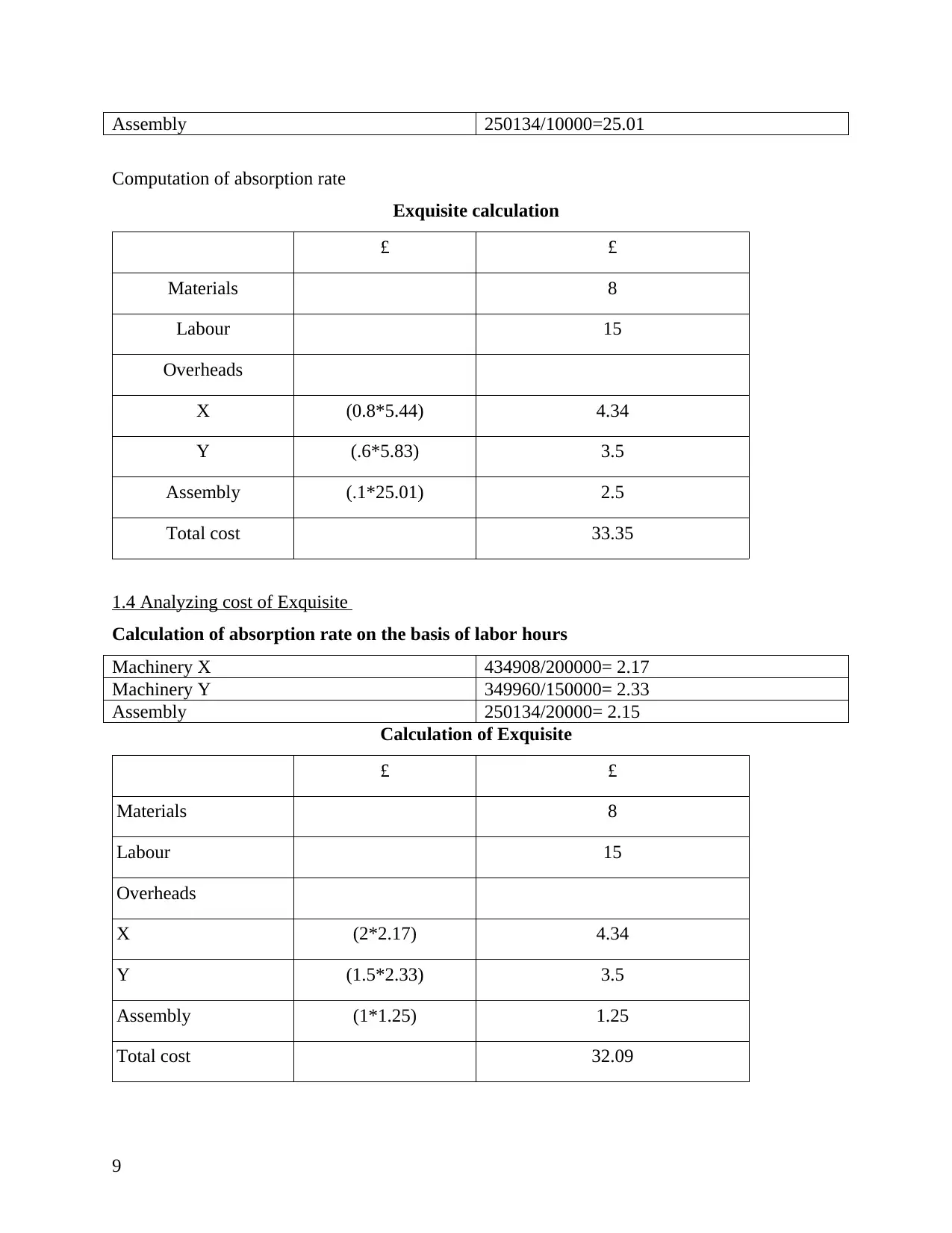
Assembly 250134/10000=25.01
Computation of absorption rate
Exquisite calculation
£ £
Materials 8
Labour 15
Overheads
X (0.8*5.44) 4.34
Y (.6*5.83) 3.5
Assembly (.1*25.01) 2.5
Total cost 33.35
1.4 Analyzing cost of Exquisite
Calculation of absorption rate on the basis of labor hours
Machinery X 434908/200000= 2.17
Machinery Y 349960/150000= 2.33
Assembly 250134/20000= 2.15
Calculation of Exquisite
£ £
Materials 8
Labour 15
Overheads
X (2*2.17) 4.34
Y (1.5*2.33) 3.5
Assembly (1*1.25) 1.25
Total cost 32.09
9
Computation of absorption rate
Exquisite calculation
£ £
Materials 8
Labour 15
Overheads
X (0.8*5.44) 4.34
Y (.6*5.83) 3.5
Assembly (.1*25.01) 2.5
Total cost 33.35
1.4 Analyzing cost of Exquisite
Calculation of absorption rate on the basis of labor hours
Machinery X 434908/200000= 2.17
Machinery Y 349960/150000= 2.33
Assembly 250134/20000= 2.15
Calculation of Exquisite
£ £
Materials 8
Labour 15
Overheads
X (2*2.17) 4.34
Y (1.5*2.33) 3.5
Assembly (1*1.25) 1.25
Total cost 32.09
9
⊘ This is a preview!⊘
Do you want full access?
Subscribe today to unlock all pages.

Trusted by 1+ million students worldwide
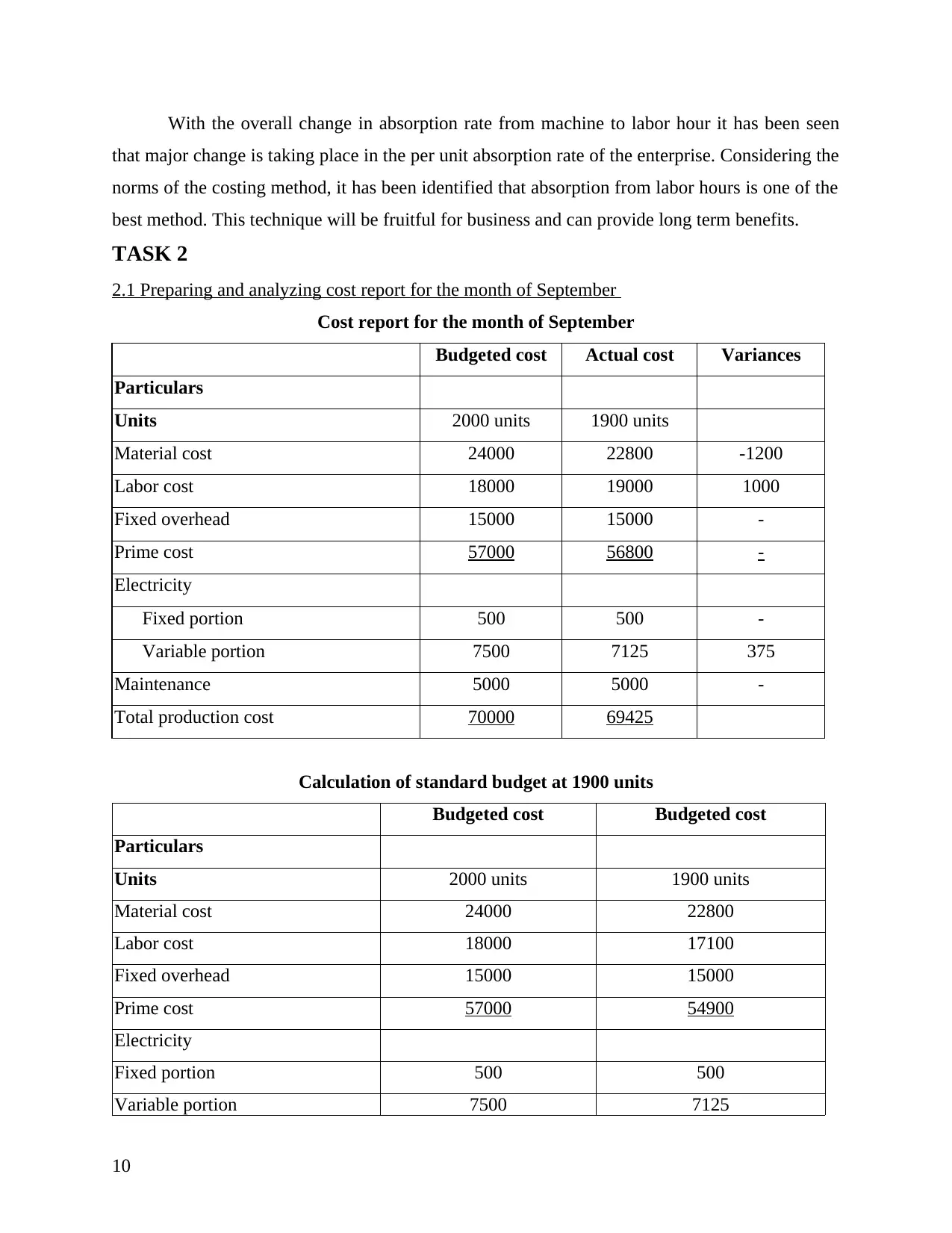
With the overall change in absorption rate from machine to labor hour it has been seen
that major change is taking place in the per unit absorption rate of the enterprise. Considering the
norms of the costing method, it has been identified that absorption from labor hours is one of the
best method. This technique will be fruitful for business and can provide long term benefits.
TASK 2
2.1 Preparing and analyzing cost report for the month of September
Cost report for the month of September
Budgeted cost Actual cost Variances
Particulars
Units 2000 units 1900 units
Material cost 24000 22800 -1200
Labor cost 18000 19000 1000
Fixed overhead 15000 15000 -
Prime cost 57000 56800 -
Electricity
Fixed portion 500 500 -
Variable portion 7500 7125 375
Maintenance 5000 5000 -
Total production cost 70000 69425
Calculation of standard budget at 1900 units
Budgeted cost Budgeted cost
Particulars
Units 2000 units 1900 units
Material cost 24000 22800
Labor cost 18000 17100
Fixed overhead 15000 15000
Prime cost 57000 54900
Electricity
Fixed portion 500 500
Variable portion 7500 7125
10
that major change is taking place in the per unit absorption rate of the enterprise. Considering the
norms of the costing method, it has been identified that absorption from labor hours is one of the
best method. This technique will be fruitful for business and can provide long term benefits.
TASK 2
2.1 Preparing and analyzing cost report for the month of September
Cost report for the month of September
Budgeted cost Actual cost Variances
Particulars
Units 2000 units 1900 units
Material cost 24000 22800 -1200
Labor cost 18000 19000 1000
Fixed overhead 15000 15000 -
Prime cost 57000 56800 -
Electricity
Fixed portion 500 500 -
Variable portion 7500 7125 375
Maintenance 5000 5000 -
Total production cost 70000 69425
Calculation of standard budget at 1900 units
Budgeted cost Budgeted cost
Particulars
Units 2000 units 1900 units
Material cost 24000 22800
Labor cost 18000 17100
Fixed overhead 15000 15000
Prime cost 57000 54900
Electricity
Fixed portion 500 500
Variable portion 7500 7125
10
Paraphrase This Document
Need a fresh take? Get an instant paraphrase of this document with our AI Paraphraser
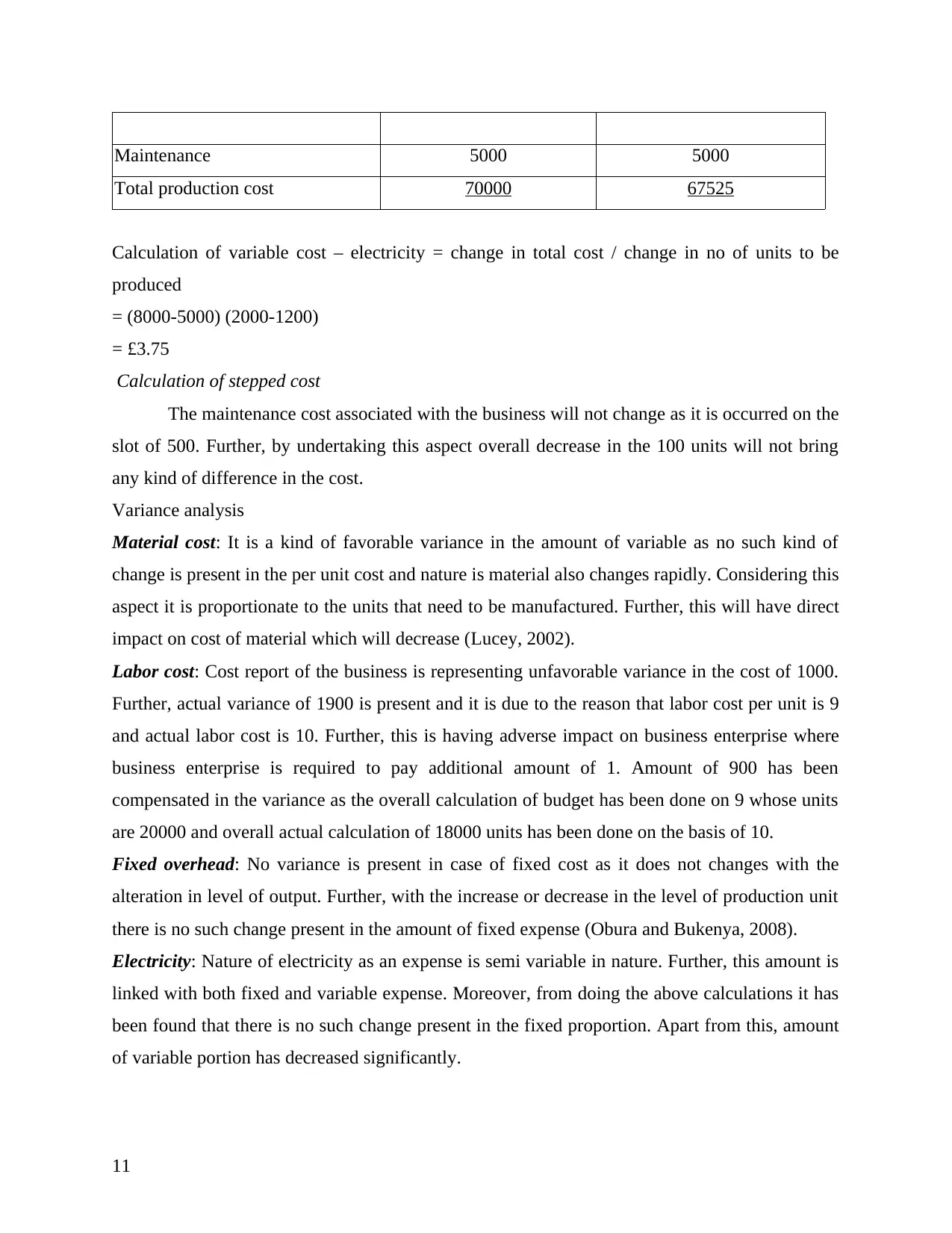
Maintenance 5000 5000
Total production cost 70000 67525
Calculation of variable cost – electricity = change in total cost / change in no of units to be
produced
= (8000-5000) (2000-1200)
= £3.75
Calculation of stepped cost
The maintenance cost associated with the business will not change as it is occurred on the
slot of 500. Further, by undertaking this aspect overall decrease in the 100 units will not bring
any kind of difference in the cost.
Variance analysis
Material cost: It is a kind of favorable variance in the amount of variable as no such kind of
change is present in the per unit cost and nature is material also changes rapidly. Considering this
aspect it is proportionate to the units that need to be manufactured. Further, this will have direct
impact on cost of material which will decrease (Lucey, 2002).
Labor cost: Cost report of the business is representing unfavorable variance in the cost of 1000.
Further, actual variance of 1900 is present and it is due to the reason that labor cost per unit is 9
and actual labor cost is 10. Further, this is having adverse impact on business enterprise where
business enterprise is required to pay additional amount of 1. Amount of 900 has been
compensated in the variance as the overall calculation of budget has been done on 9 whose units
are 20000 and overall actual calculation of 18000 units has been done on the basis of 10.
Fixed overhead: No variance is present in case of fixed cost as it does not changes with the
alteration in level of output. Further, with the increase or decrease in the level of production unit
there is no such change present in the amount of fixed expense (Obura and Bukenya, 2008).
Electricity: Nature of electricity as an expense is semi variable in nature. Further, this amount is
linked with both fixed and variable expense. Moreover, from doing the above calculations it has
been found that there is no such change present in the fixed proportion. Apart from this, amount
of variable portion has decreased significantly.
11
Total production cost 70000 67525
Calculation of variable cost – electricity = change in total cost / change in no of units to be
produced
= (8000-5000) (2000-1200)
= £3.75
Calculation of stepped cost
The maintenance cost associated with the business will not change as it is occurred on the
slot of 500. Further, by undertaking this aspect overall decrease in the 100 units will not bring
any kind of difference in the cost.
Variance analysis
Material cost: It is a kind of favorable variance in the amount of variable as no such kind of
change is present in the per unit cost and nature is material also changes rapidly. Considering this
aspect it is proportionate to the units that need to be manufactured. Further, this will have direct
impact on cost of material which will decrease (Lucey, 2002).
Labor cost: Cost report of the business is representing unfavorable variance in the cost of 1000.
Further, actual variance of 1900 is present and it is due to the reason that labor cost per unit is 9
and actual labor cost is 10. Further, this is having adverse impact on business enterprise where
business enterprise is required to pay additional amount of 1. Amount of 900 has been
compensated in the variance as the overall calculation of budget has been done on 9 whose units
are 20000 and overall actual calculation of 18000 units has been done on the basis of 10.
Fixed overhead: No variance is present in case of fixed cost as it does not changes with the
alteration in level of output. Further, with the increase or decrease in the level of production unit
there is no such change present in the amount of fixed expense (Obura and Bukenya, 2008).
Electricity: Nature of electricity as an expense is semi variable in nature. Further, this amount is
linked with both fixed and variable expense. Moreover, from doing the above calculations it has
been found that there is no such change present in the fixed proportion. Apart from this, amount
of variable portion has decreased significantly.
11
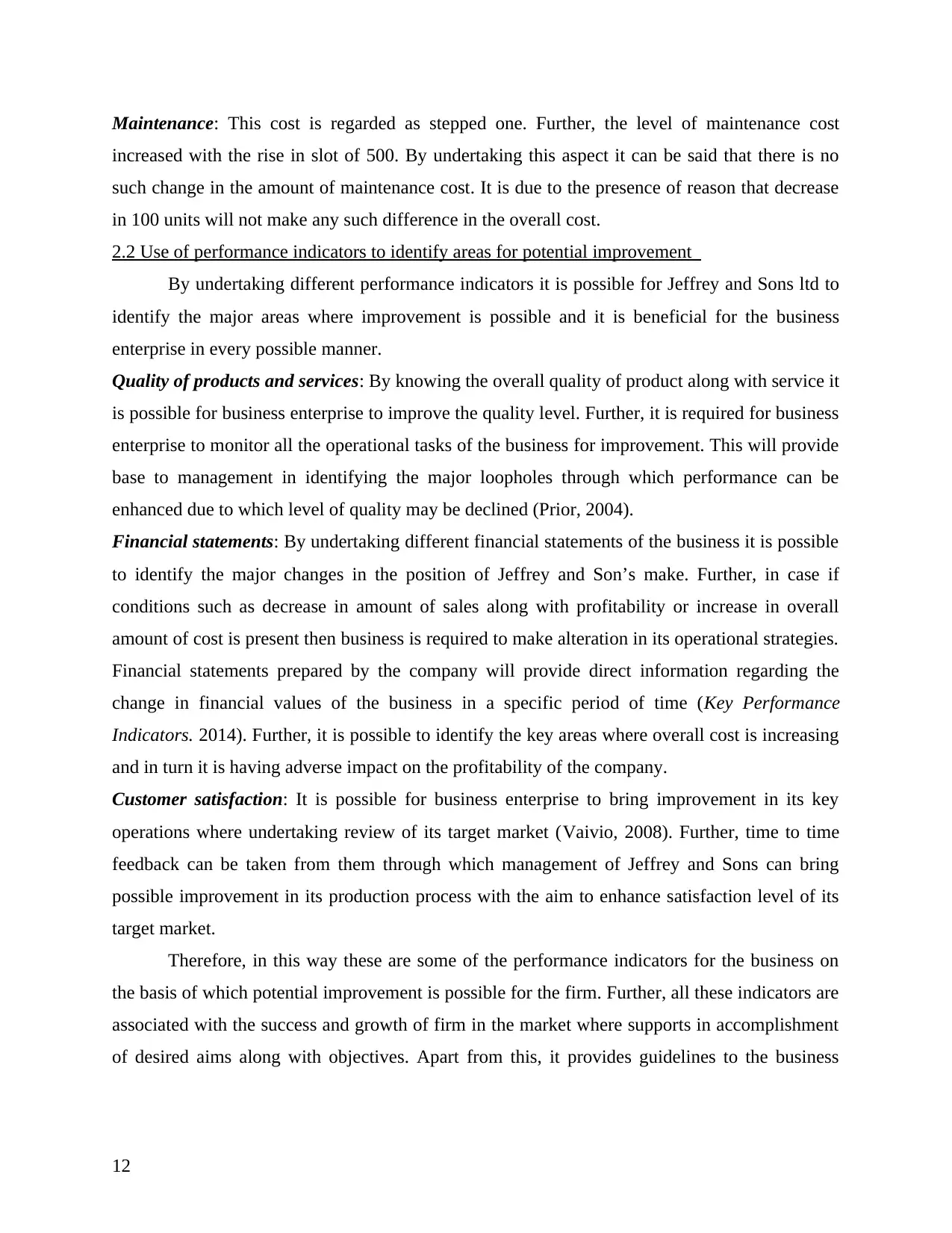
Maintenance: This cost is regarded as stepped one. Further, the level of maintenance cost
increased with the rise in slot of 500. By undertaking this aspect it can be said that there is no
such change in the amount of maintenance cost. It is due to the presence of reason that decrease
in 100 units will not make any such difference in the overall cost.
2.2 Use of performance indicators to identify areas for potential improvement
By undertaking different performance indicators it is possible for Jeffrey and Sons ltd to
identify the major areas where improvement is possible and it is beneficial for the business
enterprise in every possible manner.
Quality of products and services: By knowing the overall quality of product along with service it
is possible for business enterprise to improve the quality level. Further, it is required for business
enterprise to monitor all the operational tasks of the business for improvement. This will provide
base to management in identifying the major loopholes through which performance can be
enhanced due to which level of quality may be declined (Prior, 2004).
Financial statements: By undertaking different financial statements of the business it is possible
to identify the major changes in the position of Jeffrey and Son’s make. Further, in case if
conditions such as decrease in amount of sales along with profitability or increase in overall
amount of cost is present then business is required to make alteration in its operational strategies.
Financial statements prepared by the company will provide direct information regarding the
change in financial values of the business in a specific period of time (Key Performance
Indicators. 2014). Further, it is possible to identify the key areas where overall cost is increasing
and in turn it is having adverse impact on the profitability of the company.
Customer satisfaction: It is possible for business enterprise to bring improvement in its key
operations where undertaking review of its target market (Vaivio, 2008). Further, time to time
feedback can be taken from them through which management of Jeffrey and Sons can bring
possible improvement in its production process with the aim to enhance satisfaction level of its
target market.
Therefore, in this way these are some of the performance indicators for the business on
the basis of which potential improvement is possible for the firm. Further, all these indicators are
associated with the success and growth of firm in the market where supports in accomplishment
of desired aims along with objectives. Apart from this, it provides guidelines to the business
12
increased with the rise in slot of 500. By undertaking this aspect it can be said that there is no
such change in the amount of maintenance cost. It is due to the presence of reason that decrease
in 100 units will not make any such difference in the overall cost.
2.2 Use of performance indicators to identify areas for potential improvement
By undertaking different performance indicators it is possible for Jeffrey and Sons ltd to
identify the major areas where improvement is possible and it is beneficial for the business
enterprise in every possible manner.
Quality of products and services: By knowing the overall quality of product along with service it
is possible for business enterprise to improve the quality level. Further, it is required for business
enterprise to monitor all the operational tasks of the business for improvement. This will provide
base to management in identifying the major loopholes through which performance can be
enhanced due to which level of quality may be declined (Prior, 2004).
Financial statements: By undertaking different financial statements of the business it is possible
to identify the major changes in the position of Jeffrey and Son’s make. Further, in case if
conditions such as decrease in amount of sales along with profitability or increase in overall
amount of cost is present then business is required to make alteration in its operational strategies.
Financial statements prepared by the company will provide direct information regarding the
change in financial values of the business in a specific period of time (Key Performance
Indicators. 2014). Further, it is possible to identify the key areas where overall cost is increasing
and in turn it is having adverse impact on the profitability of the company.
Customer satisfaction: It is possible for business enterprise to bring improvement in its key
operations where undertaking review of its target market (Vaivio, 2008). Further, time to time
feedback can be taken from them through which management of Jeffrey and Sons can bring
possible improvement in its production process with the aim to enhance satisfaction level of its
target market.
Therefore, in this way these are some of the performance indicators for the business on
the basis of which potential improvement is possible for the firm. Further, all these indicators are
associated with the success and growth of firm in the market where supports in accomplishment
of desired aims along with objectives. Apart from this, it provides guidelines to the business
12
⊘ This is a preview!⊘
Do you want full access?
Subscribe today to unlock all pages.

Trusted by 1+ million students worldwide
1 out of 25
Related Documents
Your All-in-One AI-Powered Toolkit for Academic Success.
+13062052269
info@desklib.com
Available 24*7 on WhatsApp / Email
![[object Object]](/_next/static/media/star-bottom.7253800d.svg)
Unlock your academic potential
Copyright © 2020–2025 A2Z Services. All Rights Reserved. Developed and managed by ZUCOL.





